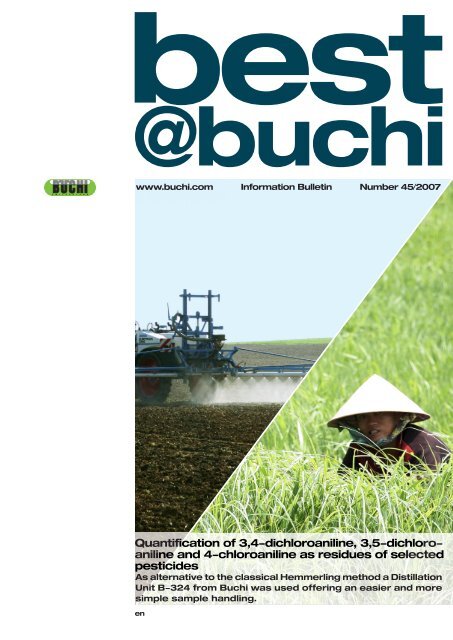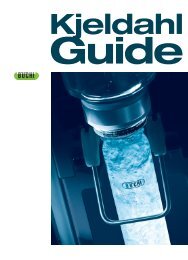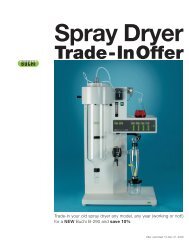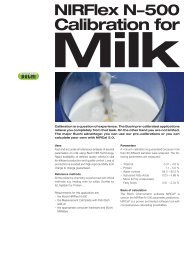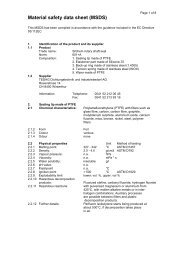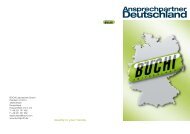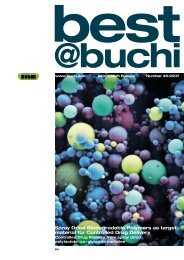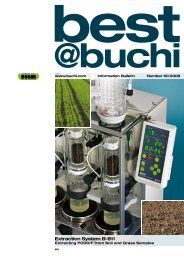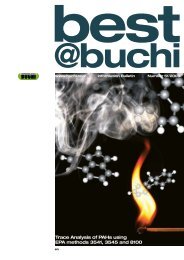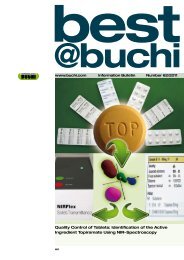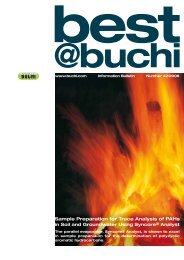Quantification of 3 4dichloroaniline, 3 5 ... - Büchi Labortechnik Gmbh
Quantification of 3 4dichloroaniline, 3 5 ... - Büchi Labortechnik Gmbh
Quantification of 3 4dichloroaniline, 3 5 ... - Büchi Labortechnik Gmbh
Create successful ePaper yourself
Turn your PDF publications into a flip-book with our unique Google optimized e-Paper software.
est<br />
@buchi<br />
www.buchi.com Information Bulletin Number 45�2007<br />
<strong>Quantification</strong> <strong>of</strong> 3,4-dichloroaniline, 3,5-dichloroaniline<br />
and 4-chloroaniline as residues <strong>of</strong> selected<br />
pesticides<br />
As alternative to the classical Hemmerling method a Distillation<br />
Unit B-324 from Buchi was used <strong>of</strong>fering an easier and more<br />
simple sample handling.<br />
en
est@buchi 45 / 2007 en<br />
Authors: Berthold Kettner 2 , Nadin Epperlein 1,2 Wolfgang Bergmüller 2 , Barbara Kramhöller 2 and Karl Speer 1<br />
Carmen Heiter 3 , Thomas Ziolko 3<br />
1 TU Dresden, Institut für Lebensmittelchemie, Bergstraße 66, D-01062 Dresden<br />
2 ILAU GmbH, Unterwöhrn 15, D-83543 Rott am Inn<br />
3 : BÜCHI <strong>Labortechnik</strong> AG, Meierseggstrasse 40, 9230 Flawil, Switzerland<br />
<strong>Quantification</strong> <strong>of</strong> 3,4�dichloroaniline, 3,5�dichloroaniline<br />
and 4�chloroaniline as residues <strong>of</strong> selected pesticides<br />
As alternative to the classical Hemmerling<br />
method a Distillation Unit<br />
B-324 from Buchi was used <strong>of</strong>fering<br />
an easier and more simple sample<br />
handling.<br />
Aniline derivative herbicides such as Diuron,<br />
Linuron, Neburon, Propanil and Swep<br />
in food samples are classically analysed<br />
using the Hemmerling method. However,<br />
this method is not easy to operate and<br />
cannot be used with samples containing<br />
starch. These samples cause strong<br />
foaming even with the use <strong>of</strong> an antifoaming<br />
agent. To counteract these problems<br />
an alternative method was developed<br />
by Epperlein et al. which can be<br />
carried out with every kind <strong>of</strong> samples and<br />
which is more user-friendly. The results<br />
are comparable to those obtained with<br />
the screening method by Hemmerling.<br />
Both methods are applied to selected<br />
pesticides and the results and handling<br />
are compared.<br />
Introduction<br />
Pesticides are used worldwide in a very<br />
high number <strong>of</strong> food cultures. In 2001,<br />
pesticides for 27.1 Billion US dollars were<br />
employed and nearly half <strong>of</strong> them were<br />
herbicides. The residues <strong>of</strong> pesticides are<br />
still detectable after several years. Responsible<br />
management <strong>of</strong> pesticides and<br />
good monitoring are therefore mandatory.<br />
Due to their affiliation to different chemical<br />
compound classes the determination<br />
<strong>of</strong> pesticides is time-consuming and costintensive.<br />
The investigated herbicides Diuron,<br />
Linuron, Neburon, Buturon, Monuron,<br />
Monolinuron and Diflubenzuron are<br />
phenyl urea derivatives while Propanil is<br />
an anilide and Swep is a carbamate.<br />
Chlozolinate, Iprodione, Procymidone and<br />
Vinclozolin are fungicides and belong to<br />
the class <strong>of</strong> dicarboximides. Their enzymatic<br />
degradation in plants, soil and<br />
mammalian liver results in chloroaniline.<br />
The same compound can be obtained in<br />
the laboratory through alkaline hydrolysis<br />
<strong>of</strong> the pesticides: 3,4-dichloroaniline<br />
(3,4-DCA) (Fig. 1), 3,5-dichloroaniline<br />
(3,5-DCA) (Fig. 2) and 4-chloroaniline (Fig. 3).<br />
Cl<br />
Cl<br />
H O<br />
N<br />
Fig 1: 3,4-DCA.<br />
Cl<br />
3,5 Dichloroaniline<br />
3,5-Dichloroaniline<br />
Fig 2: 3,5-DCA.<br />
Cl<br />
Cl<br />
Fig 3: 4-chloroaniline<br />
N<br />
CH 3<br />
CH 3<br />
Buturon<br />
O<br />
CH3 N N<br />
H<br />
OMe<br />
CH N<br />
3,4 Dichloroaniline<br />
Methods<br />
Classical method: Hemmerling<br />
NH 2<br />
Cl<br />
The most-used method for the analysis<br />
<strong>of</strong> aniline pesticides is the Hemmerling<br />
method. The metabolites <strong>of</strong> the compounds<br />
are analyzed with GC-MS after<br />
alkaline hydrolysis. The equipment employed<br />
is the Bleidner-apparatus (Fig. 4)<br />
which is not really user-friendly and due<br />
to the numerous glassware very delicate<br />
to operate. Furthermore, this procedure<br />
is not adequate for samples containing a<br />
high amount <strong>of</strong> starch. In these samples<br />
very strong foaming (Fig. 5) occurs during<br />
hydrolysis, hindering a precise measurement.<br />
Even the use <strong>of</strong> an anti-foaming<br />
agent is not helpful.<br />
F<br />
F<br />
O<br />
H<br />
O<br />
Diflubenzuron<br />
N<br />
H<br />
O<br />
H C 3<br />
N N<br />
H C H<br />
3<br />
Monolinuron Monuron<br />
Cl<br />
Cl<br />
Cl<br />
O<br />
N<br />
O<br />
O<br />
Vinclozolin<br />
H O<br />
N<br />
N<br />
O<br />
N<br />
O<br />
CH2 C<br />
H<br />
CH3 N<br />
3,4 Dichloroaniline<br />
4-Chloroaniline<br />
O<br />
N<br />
H<br />
CH 3<br />
CH 3<br />
Cl<br />
NH 2<br />
H O O<br />
3C<br />
H3C C O<br />
H2 N<br />
O<br />
O<br />
Iprodione Chlozolinate<br />
CH 3<br />
CH 3<br />
Buturon<br />
O<br />
CH3 N N<br />
H<br />
OMe<br />
Cl<br />
C<br />
H 3<br />
C<br />
H 3<br />
CH N<br />
NH 2<br />
Cl<br />
4-Chloroaniline<br />
4-Chloroaniline<br />
F<br />
F<br />
O<br />
H<br />
O<br />
Cl<br />
O<br />
N<br />
Procymidone<br />
O<br />
Diflubenzuron<br />
N<br />
H<br />
O<br />
H C 3<br />
N N<br />
H C H<br />
3<br />
Monolinuron Monuron<br />
Cl<br />
Cl<br />
Cl<br />
Cl<br />
Cl<br />
Cl<br />
Cl<br />
Fig 4: Bleidner-apparatus<br />
Fig 5: Foaming <strong>of</strong> a rice sample in a Bleidner-apparatus<br />
Alternative method: Epperlein<br />
An alternative method was developed by<br />
Epperlein in order to counteract the foaming<br />
problem. The procedure is divided into<br />
two steps. In the first step, an alkaline hydrolysis<br />
<strong>of</strong> the sample is carried out with<br />
a simultaneous steam distillation using a<br />
Kjeldahl distillation unit (Fig. 6).<br />
In the second step, an alkaline steam distillation<br />
is performed at the same time as<br />
an extraction using the Clevenger-equipment<br />
(Fig. 7).<br />
This method has several advantages in<br />
comparison with the classical Hemmerling<br />
procedure. The sample matrix is not<br />
a problem anymore, and the Clevengerapparatus<br />
must not be constantly supervised<br />
during the extraction. The resulting<br />
solution can be directly injected into a GC<br />
instrument without any further cleaning or<br />
concentrating step. The Clevenger-appa-
atus is more robust and less cost-intensive<br />
than the Bleidner-apparatus used in<br />
the Hemmerling method. All these advantages<br />
together make this method a more<br />
user-friendly and a less time-consuming<br />
analysis procedure.<br />
Fig 6: B-324 Distillation Unit Fig 7: Clevengerequipment<br />
Analysis<br />
After fine grinding, 10 g <strong>of</strong> the sample are<br />
weighed into a Kjeldahl glass. Prior to the<br />
distillation with the Buchi Kjeldahl unit,<br />
40 ml <strong>of</strong> 10 M potassium hydroxide are<br />
added. The distillation is carried out for<br />
9 min (see parameters in Table 1). The<br />
distillate is collected in a 500-ml wideneck<br />
flask containing 10 ml <strong>of</strong> 0.1 M hydrochloric<br />
acid. At the end <strong>of</strong> the distillation<br />
the pH value <strong>of</strong> the distillate should<br />
be still in the acidic range. Between the<br />
samples, the Buchi Kjeldahl unit should<br />
be rinsed thoroughly with water.<br />
Another 40 ml <strong>of</strong> 10 M potassium hydroxide<br />
as well as four boiling stones are added<br />
to the distillate. The round flask is<br />
connected to the Clevenger-equipment.<br />
The interconnection <strong>of</strong> the apparatus is<br />
first filled with 5 ml water and then 5 ml<br />
isooctane are added. After the 3 h extraction,<br />
isooctane is transferred into a 10-ml<br />
test tube and dried with 2 g sodium sulphate.<br />
The organic solution is directly injected<br />
in the GC-MS instrument (see parameters<br />
in Table 2).<br />
Distillation (Kjeldahl Distillation Unit B-324)<br />
Water 0 mL<br />
Sodium hydroxide 0 mL<br />
Boric acid 0 mL<br />
Delay 10 s<br />
Distillation 9 min<br />
Steam 75%<br />
Aspiration OFF<br />
Table 1: Parameters for distillation<br />
GC-MS conditions<br />
Capillary gaschromatograph HP 6890 split/splitless injector with autosampler HP 6890<br />
Injector: 210°C<br />
Carrier gas: Helium (Air liquide Germany GmbH)<br />
Injection volume: 2 µl pulsed splitless, purge on: 1.5 min<br />
Oven:<br />
Table 2: Parameters for GC-MS analysis<br />
Results and Validation<br />
The pesticides were analysed at different concentrations and calculated against<br />
3,4-DCA, 3,5-DCA or 4-chloroaniline. The recoveries are shown in Table 3 and 4.<br />
Calculate<br />
against<br />
3,4-DCA<br />
3,5-DCA<br />
4-Chloroaniline<br />
60°C 1 min, 40°C/min to 110°C, 6°C/min to 220°C, 20°C/min<br />
to 280°C 10 min<br />
Column: DB-35ms, 30 m x 0.32 mm x 0.25 mm<br />
Flow: Constant, 1.2 ml/min<br />
Transfer line: 300°C<br />
Mass spectrometer : HP 5972<br />
Mode : EI, positiv<br />
Ionisation energy: 70 eV<br />
Pesticides Recoveries in %<br />
0.005 mg/kg 0.01 mg/kg 0.05 mg/kg 0.1 mg/kg 0.3 mg/kg 0.5 mg/kg<br />
Diuron - - 68.7 70.1 - -<br />
Linuron - 83.6 89.8 92.5 - -<br />
Neburon - 93.4 94.1 96.4 - -<br />
Propanil - 94.9 92.0 91.2 - -<br />
Swep - 73.7 75.8 75.3 - -<br />
Chlozolinate - 84.8 78.4 83.4 93.9 -<br />
Iprodione - 39.5 31.6 37.4 35.5 -<br />
Procymidone - 100.2 96.6 99.6 102.0 -<br />
Vinclozolin - 103.6 101.1 107.2 108.2 -<br />
Buturon 16.2 7.3 4.0 3.4 3.3 3.2<br />
Diflubenzuron 83.1 85.0 93.7 83.5 84.5 89.5<br />
Monolinuron 111.9 111.4 133.2 111.9 128.4 129.2<br />
Monuron 98.1 101.6 114.9 118.0 123.2 132.7<br />
Table 3: Recovery <strong>of</strong> each pesticide (method: Epperlein et al. 3,4 )<br />
The recoveries for the metabolite 3,4-DCA are between 65 and 100% and for the metabolites<br />
3,5-DCA and 4-chloroaniline between 83.4 and 133.2%. The lower recoveries<br />
for Buturon (3.3 – 16.2%) and for Iprodione (31.6 – 39.5%) are comparable with the<br />
recoveries <strong>of</strong> the screening method by Hemmerling (Table 4). Both methods are not<br />
suitable for the determination <strong>of</strong> Buturon and Iprodione.<br />
best@buchi 45 / 2007 en
est@buchi 45 / 2007 en<br />
Pesticide Recoveries in %<br />
According to Epperlein et al. 4 According to Hemmerling 2<br />
0.05 mg/kg 0.1 mg/kg 0.05 mg/kg 0.1 mg/kg<br />
Buturon 4.0 3.4 5.8 5.0<br />
Iprodion 31.6 37.4 37.4 38.6<br />
Table 4: Recoveries <strong>of</strong> Buturon and Iprodione<br />
The limit <strong>of</strong> quantification (LOQ), the limit <strong>of</strong> detection (LOD) and the lowest legally allowed<br />
maximum residue level for some selected pesticides are shown in Table 5.<br />
A comparison <strong>of</strong> both methods with different native rice samples showed the same<br />
results (Table 6). The alternative method has a good reproducibility and is therefore<br />
more appropriate for the comparison among different laboratories.<br />
Conclusion<br />
The alternative method by Epperlein at al. can be used as a routine analysis procedure.<br />
Compared to the classical Hemmerling method, this new method is less timeconsuming,<br />
easier to perform and adequate for all types <strong>of</strong> samples.<br />
The quantification <strong>of</strong> the 3,4-DCA, 3,5-DCA and 4-chloroaniline with this new method<br />
has shown excellent results in terms <strong>of</strong> recovery, limit <strong>of</strong> detection and handling. The<br />
aniline derivative pesticides can be easily analyzed with this method.<br />
BÜCHI <strong>Labortechnik</strong> AG<br />
Postfach<br />
9230 Flawil 1<br />
Schweiz<br />
T +41 71 394 63 63<br />
F +41 71 394 65 65<br />
buchi@buchi.com<br />
www.buchi.com<br />
BUCHI Corporation<br />
19 Lukens Drive, Suite 400<br />
New Castle<br />
Delaware 19720<br />
USA<br />
T +1 302 652 3000<br />
F +1 302 652 8777<br />
Toll Free: +1 877 692 8244<br />
us-sales@buchi.com<br />
www.mybuchi.com<br />
BÜCHI <strong>Labortechnik</strong> GmbH<br />
Postfach 10 03 51<br />
45003 Essen<br />
Deutschland<br />
Freecall 0800 414 0414<br />
T +49 201 747 490<br />
F +49 201 237 082<br />
deutschland@buchi.com<br />
www.buechigmbh.de<br />
BUCHI Hong Kong Ltd.<br />
1810 Fortress Tower<br />
250 King’s Road<br />
North Point, Hong Kong<br />
China<br />
T +852 2389 2772<br />
F +852 2389 2774<br />
china@buchi.com<br />
www.buchi.com<br />
We are represented by more than 100 distribution<br />
partners worldwide. Find your local representative at<br />
www.buchi.com<br />
lowest legally allowed<br />
maximum residue level 1 LOQ * LOD *<br />
Diuron 0.05 0.03 0.010<br />
Linuron 0.05 0.01 0.003<br />
Neburon 0.05 0.01 0.003<br />
Propanil 0.05 0.01 0.003<br />
Swep 0.01 0.01 0.003<br />
Chlozolinate 0.05 0.01 0.003<br />
Procymidone 0.02 0.01 0.003<br />
Vinclozolin 0.05 0.01 0.003<br />
Diflubenzuron 0.05 0.01 0.003<br />
Monolinuron 0.05 0.01 0.003<br />
Monuron 0.05 0.01 0.003<br />
*calculated with “Kalibo” according to DIN 32645<br />
Table 5: Limit <strong>of</strong> quantification and limit <strong>of</strong> detection (method: Epperlein et al.)<br />
Rice<br />
TU DresdenMethod according<br />
to Hemmerling 2<br />
ILAU GmbHMethod according to<br />
Epperlein et al. 3<br />
A 0.02<br />
Results in mg/kg<br />
0.02 0.03<br />
B 0.02 0.02 0.02<br />
C 0.01 0.03 0.02<br />
D 0.06 0.07 0.08<br />
Table 6: Interlaboratory Recovery Test” with native rice samples<br />
BÜCHI <strong>Labortechnik</strong> GmbH<br />
Branch Office Netherlands<br />
Postbus 142<br />
3340 AC Hendrik-Ido-Ambacht<br />
The Netherlands<br />
T +31 78 684 94 29<br />
F +31 78 684 94 30<br />
netherlands@buchi.com<br />
www.buchi.nl<br />
BUCHI Shanghai Trading LLC<br />
21/F Shanghai Industrial<br />
Investment Building<br />
18 Caoxi Bei Road<br />
200030 Shanghai<br />
China<br />
T +86 21 6468 1888<br />
F +86 21 6428 3890<br />
china@buchi.com<br />
www.buchi.com<br />
BÜCHI Italia s.r.l.<br />
Centro Direzionale, Milano Fiori<br />
Pal. A-4, Strada 4<br />
20090 Assago (MI)<br />
Italia<br />
T +39 02 824 50 11<br />
F +39 02 57 51 28 55<br />
italia@buchi.com<br />
www.buchi.it<br />
BUCHI UK Ltd<br />
5 Whitegate Business Centre<br />
Jardine Way<br />
Chadderton<br />
Oldham OL9 9QL<br />
United Kingdom<br />
T +44 161 633 1000<br />
F +44 161 633 1007<br />
uk@buchi.com<br />
www.buchi.co.uk<br />
Literature<br />
[1] Verordnung über Höchstmengen an<br />
Rückständen von Pflanzenschutz-<br />
und Schädlingsbekämpfungsmitteln,<br />
Düngemitteln und sonstigen Mitteln<br />
in oder auf Lebensmitteln (Rückstands-Höchstmengenverordnung<br />
–<br />
RHmV) in der Neufassung vom<br />
21.10.1999, 18. Verordnung zur Änderung<br />
der Rückstands-Höchstmengenverordnung<br />
vom 20.04.2007<br />
[2] Hemmerling, C: Screeningmethode<br />
zur schnellen Untersuchung von Lebensmitteln<br />
auf Rückstände von Phenylharnst<strong>of</strong>fherbiziden<br />
und weiteren<br />
PSM-Wirkst<strong>of</strong>fen durch alkalische<br />
Hydrolyse und GC-MS-Bestimmung,<br />
Deutsche Lebensmittel-Rundschau<br />
95, 350-361 (1999)<br />
[3] Epperlein et al. : Die Quantifizierung<br />
von Rückständen ausgewählter Herbizide<br />
(Diuron, Linuron, Neburon,<br />
Propanil und Swep) in Lebensmitteln<br />
nach alkalischer Hydrolyse mit Hilfe<br />
der GC/MS, Deutsche Lebensmittelrundschau<br />
102, 53-57 (2006)<br />
[4] Kettner et al. : Die Bestimmung von<br />
3,5-Dichloranilin und 4-Chloranilin<br />
mittels GC/MS-Analytik nach alkalischer<br />
Hydrolyse ausgewählter Pflanzenschutzmittel,<br />
Deutsche Lebensmittel-Rundschau<br />
103, 4-7 (2007)<br />
BUCHI (Thailand) Ltd.,<br />
77/175, Sin Sathon Tower,<br />
39th FL, Unit F<br />
Krungthonburi Rd.<br />
Klongtonsai, Klongsan<br />
Bangkok 10600<br />
Thailand<br />
T +66 2 862 08 51<br />
F +66 2 862 08 54<br />
bacc@buchi.com<br />
www.buchi.com<br />
BUCHI Sarl<br />
5, rue du Pont des Halles<br />
Z.A. du Delta<br />
94656 Rungis Cedex<br />
France<br />
T +33 1 56 70 62 50<br />
F +33 1 46 86 00 31<br />
france@buchi.com<br />
www.buchi.fr<br />
BUCHI SMP<br />
Services Private Ltd.<br />
201, Magnum Opus<br />
Shantinagar Industrial Area<br />
Vakola, Santacruz (East)<br />
Mumbai 400 055,<br />
India<br />
T +91 22 66 98 94 50 / 51<br />
F +91 22 66 98 94 52<br />
smplisp@vsnl.com<br />
www.buchi.com<br />
Nihon BUCHI K.K.<br />
3F IMON Bldg.,<br />
2-7-17 Ikenohata, Taito-ku,<br />
Tokyo 110-0008<br />
Japan<br />
T +81 3 3821 4777<br />
F +81 3 3821 4555<br />
nihon@buchi.com<br />
www.nihon-buchi.co.jp<br />
Quality in your hands


